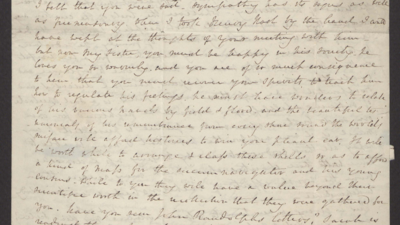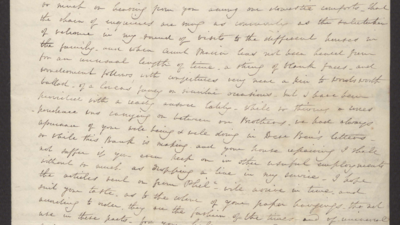Oral History Interview with Hanna Seckel
Title
Date
Contributor
Summary
Hanna Seckel1, nee Dubová, born July 22, 1925 in Kolin Czechoslovakia, grew up in Prague in a middle-class, secular family. Her father was a doctor. Hanna describes her early childhood education, getting involved in a Zionist Youth Movement, and the German occupation of Sudetenland including school closings and restrictions imposed on Jews.
In October 1939, when she was 14 years old, she was sent to Denmark as part of a transport of children from HashomerHatzair sponsored by the Danish League of Peace and Freedom. Hanna describes her life and work in Denmark in great detail. She worked at two farms under harsh conditions. One was near Gørløse,the other near Næstved where she had contact with other children from the transport.Through letters from her family she learned about worsening conditions of Jews in Prague. In 1942 her parents wrote that they would be deported to Auschwitz and she attempted suicide. She briefly mentions the Danish underground.
Hanna recalls working as a chambermaid at a Danish boarding school in exchange for her tuition there and also for a family in Næstved after she quit school in 1943. She details her feelings of being an outsider and her financial difficulties. She discusses the fates of some of the other refugee children—some reached Palestine, some were caught, some were sent back to their original countries by Denmark and sent to concentration camps. She also describes her rescue by the Danish underground and the harrowing journey to Sweden hidden in a fishingboat. The Chief Rabbi of Copenhagen, Rabbi Melchior, was part of the group. She details the warm reception by the Swedes and aid from the Red Cross.
Hanna describes her life in Sweden working as a maid for room and board at two different nursing schools inNorrköpingand Södertälje, losing touch with her former friends, receiving ng her nursing certificate and working in an insane asylum.
Hanna returned to Denmark in 1945 because she heard that she was entitled to Danish citizenship which was not true. In Copenhagen she worked in a restitution office for Danish Jews. She returned to Prague in 1946 and lived with relatives whileearning a degree from Charles University, then returned to Denmark on a Nansen Pass in 1947. After a lengthy illness, she went to Sweden and worked in a factory owned by the Nobel family, as a translator. In 1950, she emigrated to the United States under the Czech quota.
none
More Sources Like This
of
Luba Margulies
Luba Kozusman Margulies, born in Novogrod, Poland in 1915, was raised in Ostrog after her parents were killed in a pogrom. She talks about her family history; her life and education in both Ostrog and Lemberg (L’vov), where she studied to become a midwife, and experienced antisemitism, including a violent encounter with Polish members of the Hitler Jugend.
She describes life in Tarnopol - where she moved after her marriage in 1940 - under both Russian and German occupation, when the killing of Jews started in 1941. She describes mass murders of Jews by both Germans and Ukrainians, roundups of Jews, especially rabbis, and her work in hospitals in Tarnopol and later the ghetto. She gives a detailed description of life in the ghetto, which existed for less than a year and was liquidated in 1942, including surviving, attempts by Jews to construct escape bunkers, activities of the Judenrat, and forced labor. Luba and her husband were in a forced labor group that worked outside of the ghetto.
She relates several episodes of preparing hiding places, hiding in sewers with other survivors, repeated attempts by Germans to flush out and kill Jews by various means. Luba and her husband escaped, were caught and put into a labor camp. She believes that Untersturmführer Rokita, the head of this labor camp, ordered the massacre of these Jews. Luba graphically describes their escape from the labor camp, hiding in a hole in the ground and in the home of a non-Jewish man for weeks, scavenging for food, being hunted by Germans, and instances of help by non-Jews.
After liberation by advancing Russian soldiers March 24, 1944, they fled to escape conscription. They lived briefly in Tarnopol, in Brzezany with other survivors, and in Walbrzech in the home of a German-Christian family. Luba and her family went to a Displaced persons camp in Wetzlar, near Stuttgart, Germany. She came to the United States with her husband and two daughters in October, 1949. The interview concludes with several sad vignettes about the fate of some children in the ghetto who were taken from their parents and also includes a poem written by Luba’s husband, in Yiddish and English.
Interviewee: MARGULIES, Luba Kozusman Date: October 20, 1981
of
Ilsa R. Katz
Ilsa R. Katz was born December 10, 1921 in Venningen, Pfalz, Germany. Her father was a kosher butcher and a World War I veteran. She briefly describes her life and education (both secular and religious) before and after Hitler came to power including the escalating anti-Jewish restrictions and increasing antisemitism.
During Kristallnacht, November 9, 1938, their synagogue was burned and all Jewish men were arrested. A non-Jewish villager saved the Torah scroll. The next morning all Jews were rounded up and deported by bus to a meadow near Karlsruhe, Baden.
Because her father had obtained Visas, Ilsa and her family were able to leave for the United States from Hamburg, Germany to Philadelphia in December 1938. Most of her relatives were deported and killed. Ilsa talks about their life in Philadelphia, how they made a living and adjusted to life in America.
Interviewee: KATZ, Ilsa R. Date: Sept. 11, 1989
of
Joseph Levy
Joseph Levy was born on August 22, 1911 in Eschweiler, Germany. Despite antisemitic harassment during childhood, he enjoyed his childhood in public and private Jewish schools and in a Jugendbund youth group.
On January 31, 1933, his father and older brother—warned by a friendly local Nazi leader—fled before storm troopers ransacked their butcher shop in Siegburg. Some Christian employees helped shelter the family at that time and later delivered a ransom for the father’s release from Dachau.
In 1937, Joseph obtained an American visa and joined his siblings in New York City. Their parents followed, aided by the Red Cross and a Jewish organization. They sailed in a fishing boat from Barcelona, with a brief stay in Cuba, before arriving in the United States in December 1941.
Most of this interview narrates the stories of his father in hiding and forced labor and his brother in resistance groups in France and Spain (both of whom had already died at the time of this interview).
of
Frieda Appel
Frieda Appel, née Gottesman or Feldstein, was born into an Orthodox family August 18, 1929 in Kliachanovo, Czechoslovakia, near Munkács. Her father was a cattle dealer. Although, Frieda and her brother were offered shelter by the sheriff, a close friend of her father’s, her father decided to keep the family together. They were sent to the Munkács Ghetto for four weeks until transported to Auschwitz in May 1944. She refers to several interactions with Mengele, upon entering the camp and at a selection at the showers. After six weeks, she was sent to Gelsenkirchen and Essen labor camps. She was transported to Bergen-Belsen and describes the conditions there. She refers to several kindnesses shown to her by camp personnel in the different camps. She was liberated in Bergen-Belsen April 15, 1945. The Red Cross took her and her sister to Prague through Pilsen, and then to Munkács. In May 1946, she went to a DP camp in Germany where she married at age 16. They emigrated to the United States September 27, 1949, where Jewish Family Service helped them.
Recorded at the 1985 American Gathering of Holocaust Survivors in Philadelphia, PA.

